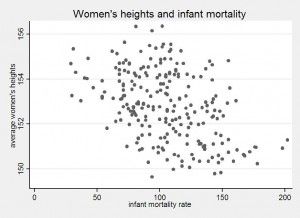Adult height and early childhood environments
— Blog Post — 2 min read
It has long been thought that an important determinant of adult height is the environment in which a child grows up. Children who grow up in environments free of disease and with access to good nutrition will be taller, on average, than children who grow up in places with lots of disease and poor nutrition.
In 2009, Carlos Bozzoli, Angus Deaton and Climent Quintana-Domeque published an article in Demography entitled “Adult height and childhood disease.” They used data from 1950 to 1980 in western Europe and the US to show that there is a strong and robust relationship between the heights of adults born in those countries and those years and the level of post neonatal mortality in their countries around the time of when they were born. (Post neonatal mortality is the fraction of babies born alive who die between the ages of 1 and 12 months old.) They hypothesize that height is related to post neonatal mortality because, where post neonatal mortality is high, there is a lot of disease in the childhood environment. Exposure to this disease means that children spend their energy figthing disease as opposed to growing tall.
I wondered whether it would be possible to find this relationship within India as well. In order to do the same exercise with Indian data, I would have to find mortality rates from when adult women alive today were young. Luckily, in 1970, the Indian government started a special program to collect vital statistics about its population, called the Sample Registration System. Vital statistics, which are information about births, deaths, and marriages in a population, were collected for the larger states every year.
I went to look for data from the Sample Registration System in the bowels of the Office of Population Research’s amazing population library. I was lucky enough to find big, heavy books, with tables of infant mortality rates from the 1970s and 1980s collected through the Sample Registration System. (As an aside, a few months ago, I wrote a blog post about the importance of administrative record keeping. The work I’ve been doing in the last couple of weeks makes me want to singing the praises of good record keeping even louder!)
When I entered the data on infant mortality rates into the computer and compared it to adult heights in the relevant states and years, I found that there was indeed a negative relationship. The graph below shows this relationship.

It looks like women who were born in places and times when the infant mortality rate was 50 (mean that out of 1000 babies born alive in a year, 50 die before reaching their first birthday) are over 4 centimeters taller, on average, than women born in places and times when the infant mortality rate was 150!
This analysis is only a starting point for understanding what leads to variation in adult heights. It looks, at this point at least, that mortality in the first month of life is more closely associated with adult height than post neonatal mortality. If true, this would be a departure from the findings from western Europe and the US. I’ll keep you posted as I keep working with these data.